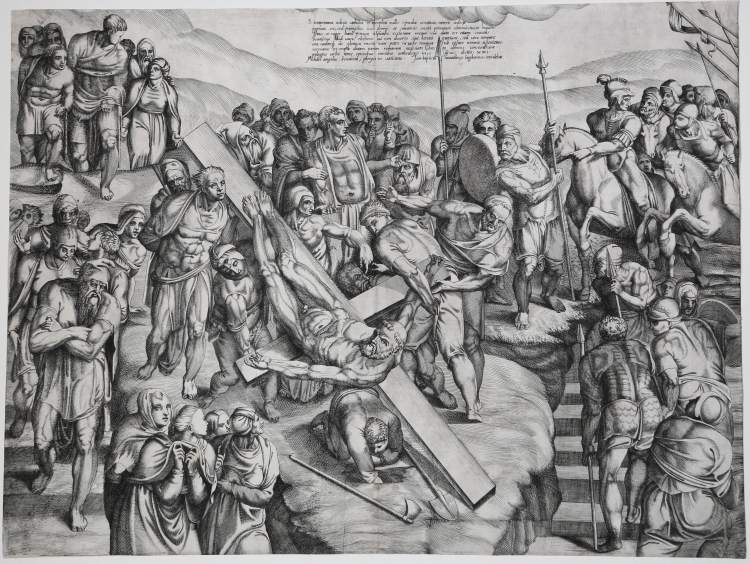



| Reference: | S38426 |
| Author | Giovanni Battista de’ CAVALIERI |
| Year: | 1567 ca. |
| Measures: | 560 x 440 mm |


| Reference: | S38426 |
| Author | Giovanni Battista de’ CAVALIERI |
| Year: | 1567 ca. |
| Measures: | 560 x 440 mm |
Engraving, inscribed upper centre: Sancta romana ecclesia catholica et apostolica nullis sÿnodias constitutis ecclesiis/ proelata est, sed evangelica voce domini et salvatoris nostri primatum obtinuit, tu es iniquiens/ Petrus et super hanc petram edificabo ecclesiam meam. cui data est etiant societas/ beatissimi Pauli vasis electionis qui non diverso sicut heretici garriunt, sed uno tempore/ una cadanque die gloriosa morte cum petro in urbe romana sub cesare nerone agonizans/ coronatus est: et supra dictam pariter romanam ecclesiam Christo domino consecrarunt/ pelagius urbis romea episcopus omnibus orthodixis in j.c. q. vis distin: xxi./ Michaelangelis: bonarota i pinxit in Vaticano. Joa. baptista cavallerijs lagherinus incidebat.
After the fresco by Michelangelo, reversed, in the Capella Paolina.
A very good impression, printed with tone on contemporary laid paper with “star in a cricle” watermark, (cfr. Briquet 6097), trimmed to the platemark, vertical paper folds, perfectly executed repairs at the upper corners, generally in good condition.
There are two sixteenth-century prints of the Michelangelo fresco; the first is an etching by Michele Lucchese, made between 1549 -1560 the second one is this engraving by Cavalieri.
Cavalieri’s print reflects the state of the fresco before 1564 when loincloths and other changes were made, but there is reason to believe that it was made at the same time as his print of “The Last Judgment”, which is dated 1567.
The long Latin inscription explains the significance of the image with specific reference to the controversies surrounding the papacy at the time. The inscription quotes a fourth-century decree that established the bishop of Rome as head of the church; it was later used in defenses of the primacy of the pope.
The inscription provides a context for viewing this print: it is too be seen as a justification of papal authority against Protestant heresies. Perhaps the engraving was made for a learned clerical audience who would fully appreciate the references, but it must have appealed to others viewers as well. Vasari praises Cavalieri’s prints after the Pauline Chapel as being among the best reproductions of Michelangelo’s work. He says nothing about the inscription. It appears that Vasari, looking for information about a painting that was not easily accesible, could easily ignore the learned message of the inscription.
Bibliografia: Heinecken, I (1768), P. 392, N. 28/A; Huber, Ii-I (1803), P. 619, N. 2784; Gori Gandellini, De Angelis, Viii, 1810, P. 94, N. 46; Le Blanc, I, P. 616, N. 27; Passerini, P. 177; Neumeyer, P. 181, N. 2; Scorsetti, P. 16, N. 53; Barnes, P. 194, N. 67; Alberti, N. 221
Giovanni Battista de’ CAVALIERI (1525-1601)
|
Engraver,printer and print publisher,from Villa Lagarina near Trento.Active in Venice and from 1559 in Rome.1577 he had a bottega in Parione which he let out to a cartolaio,Girolamo Agnelli. His own house was in the vicolo di Palazzo Savelli, with a workshop next to it. He was the brother-in-law of Lorenzo Vaccari.
Made plates for Antonio Salamanca, Lafrery and Faleti.By 1560 he seems to have been publishing his own plates. He entered into partnerships for publishing: in 1567 with Perino Zecchini de Guarlottis and in 1576 with Lorenzo Vaccari .In 1577 he was employng a printer: Francesco Cornuti .He acquired old plates that he recut. He published plates by his contemporaries,including Cort.He himself engraved after works of many artists,including Cort.He himself engraved after works of many artists,including Francesco Salviati,Daniele da Volterra, Raphael, Michelangelo, Polidoro da Caravaggio, Livio Agresti and Baccio Bandinelli.He also made copies of earlier prints.His subject matter included the devotional topographical,antiquarian,didactic and ‘popular’.
He published a number of important series: the Pontificum Romanorum Effigies of 1580 and the Romanorum Imperatorum Effigies of 1583; the Ecclesiae Anglicanae Trophea of 1584; the Antiquarum Statuarum Urbis Romae, the first book of which was first published before 1561/2.
|
Giovanni Battista de’ CAVALIERI (1525-1601)
|
Engraver,printer and print publisher,from Villa Lagarina near Trento.Active in Venice and from 1559 in Rome.1577 he had a bottega in Parione which he let out to a cartolaio,Girolamo Agnelli. His own house was in the vicolo di Palazzo Savelli, with a workshop next to it. He was the brother-in-law of Lorenzo Vaccari.
Made plates for Antonio Salamanca, Lafrery and Faleti.By 1560 he seems to have been publishing his own plates. He entered into partnerships for publishing: in 1567 with Perino Zecchini de Guarlottis and in 1576 with Lorenzo Vaccari .In 1577 he was employng a printer: Francesco Cornuti .He acquired old plates that he recut. He published plates by his contemporaries,including Cort.He himself engraved after works of many artists,including Cort.He himself engraved after works of many artists,including Francesco Salviati,Daniele da Volterra, Raphael, Michelangelo, Polidoro da Caravaggio, Livio Agresti and Baccio Bandinelli.He also made copies of earlier prints.His subject matter included the devotional topographical,antiquarian,didactic and ‘popular’.
He published a number of important series: the Pontificum Romanorum Effigies of 1580 and the Romanorum Imperatorum Effigies of 1583; the Ecclesiae Anglicanae Trophea of 1584; the Antiquarum Statuarum Urbis Romae, the first book of which was first published before 1561/2.
|